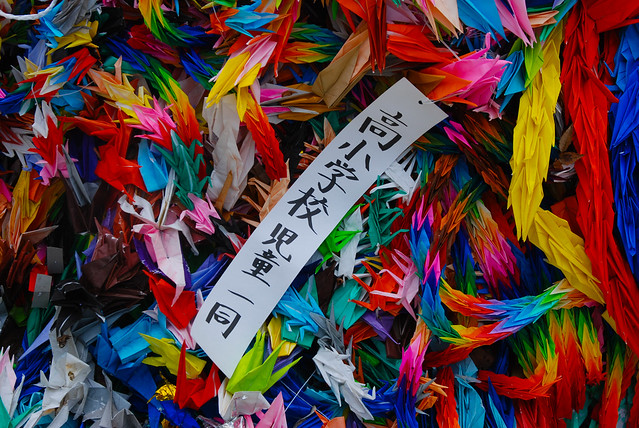I've now been learning Japanese for about three years – long enough to get a decent grip on everyday verbs, adjectives and nouns, and to start wrestling with kanji (80ish, so far). But there's only so far you can get by speaking for 90 minutes per week in classes. So, I hatched a plan: to get to Japan as cheaply as possible and spend a few days practicing.
In the end, I managed to tour pretty much the entire lower half of Honshu quite inexpensively, and it was a great experience. In case it's handy to anyone planning something similar, this handful of blog posts – you can see the whole series here – will outline where I went, what I did, and how I kept the budget down.
Old Japan in Nara
Planes and Trains
My original idea was to fly in on the cheapest, crappest route possible, take the train to Kyoto and spend some time there. This went completely awry, but in a good way. First, air fares plummeted: I was able to get a direct flight from Heathrow to Narita for around £650, which is far less than we paid the other year, and even then the plane was half empty.
Cranes, Hiroshima
Booking on Virgin Atlantic gets you a choice between Virgin and ANA flights – in my experience Virgin's Tokyo planes are similar to others in the fleet – a bit knackered, with not enough legroom to sleep and mediocre food – while ANA's plane was immaculate, with more legroom and better (Japanese) meals. Given the choice, pick the latter – ANA were better than JAL, too.
A rainy Tokyo on the day I landed
Secondly, I found that getting a Shinkansen from Tokyo to Kyoto costs around £200, so you might as well pay £250 or so for the 7-day Japan Rail Pass, which gets you unlimited travel on all JR lines, with a few minor restrictions. I planned for eight days, but after my original flight was cancelled ended up with nine, during seven of which I could travel pretty much anywhere. In the end my route took me from Tokyo, through Kyoto, Fukuchiyama, Kinosaki, Hiroshima, Nara and Yokohama, then back to Tokyo for one day before leaving.
Shinkansen – the best train service in the world
I really cannot recommend the Rail Pass enough. I must have used well over £1,000 worth of train travel, all for one fixed price, and on many trains you don't even need to pick up any other ticket. For those that do, you can use it to make reservations on Limited Express and Shinkansen services – the fastest Nozomi ones are exempt, but that doesn't matter much as you can use the almost-as-fast Hikari and Sakura services. The Rail Pass must be purchased before you travel to Japan – it is not sold there at all – and must be started within three months of purchase. In London, visit the Japan Travel shop under Mitsukoshi Department Store (which also sells tickets to the Ghibli Museum, if you haven't been!).
New Japan in Ginza, Tokyo
Armed with a pass I spent 15 minutes in the JR Kyoto Eki ticket office booking ten or so journeys, which got me a guaranteed seat on even busy trains – reassuring when you're lugging a large rucksack. And the trains, of course, are fantastic. Even the oldest, crappiest (not very crappy) local ones run on time, while the Shinkansen are more comfortable than most aeroplanes I've been on (especially the reserved seating on Sakura services). It's a great way to travel.
The local train from Kyoto to Inari
Hotels and Hiking
With travel sorted, I aimed to travel not on the cheap, but relatively cheaply – no more than £120 a day, including accommodation. This is, fortunately, pretty easy – most cities have cheapish business hotels that have many single rooms that run from £50 (out in Kansai) to £90ish (Shinjuku, Tokyo). The Sunroute chain, in particular, is handy: you can reserve rooms online in advance with no deposit, and they're all good, no-frills places (think Travelodge, but often a bit nicer). Outside Tokyo and Kyoto I also found some cheap ryokan accommodation, which makes a nice change.
Add on one cheap restaurant meal a day, breakfast in a coffee shop and some onigiri for lunch, and you don't have to spend a fortune, even with the horrendously high Yen – but bear in mind that sightseeing and transport can be expensive. A day visiting temples in Kyoto, for example, must have set me back £50 at least just on entrance fees. Similarly, non-JR travel (Tokyo's subway lines, for example), quickly become costly if you're moving around a lot.
Okonomiyaki in Hiroshima – cheap and delicious
To cover my route you'll need luggage you can carry (a decent rucksack) and to be happy to walk 5km or so at a time carrying it. My route also required a couple of eyeball-hurtingly-early starts, and judicious use of train station lockers to hold baggage when passing through towns. All big stations have these, although they fill up in the mornings, and they can be hard to find – ask 'すみません、コインロッカーはどこですか' (sumimasen, coin-ro-kah wa doko des ka?). Backpack sized ones normally cost 600Y for storage until 1am the next day.
Oh, and one other recommendation: just before leaving I grabbed a copy of the new Lonely Planet
So, that's that. I flew in and out of Tokyo – more on that city here.

























